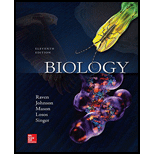
Concept explainers
Introduction:
Behavior is a term that describes what an animal does. It is a way through which an animal responds to environmental stimulus with the help of signals like visual, odor, or sound associated with mating, avoiding predators or to search food. Behavior helps an animal to survive and reproduce by monitoring social environment, making decisions, and thinking. Ethology is the study of animal behavior.
Answer to Problem 1U
Correct answer:
Ethologists suggested that the behavior in animals is controlled by the nervous system through an innate releasing mechanism which is a neural circuit that triggers the motor programs called fixed action patterns and is involved in the interpretation of key stimulus that triggered the action. They generalized that key stimulus is the environmental signal that starts the neural circuit which causes behavior. Innate releasing mechanisms are those sensory parts in the body that detect the signal and muscles controlled by neural circuits to generate a fixed action pattern. Therefore option b. is the correct answer.
Explanation of Solution
Reason for the correct statement:
A key stimulus is the environmental signal that starts the neural circuit which causes behavior. The innate releasing mechanism includes sensory parts in the body that detect the signal and muscles controlled by neural circuits to generate a fixed action pattern. Thus, key stimulus, innate releasing mechanism and fixed action pattern are the innate components of behavior.
Option b. is given as “are components of behaviors that are innate”.
As, “a key stimulus, innate releasing mechanism, and fixed action pattern are components of behaviors that are innate”, is the right answer.
Hence option b. is correct.
Reasons for the incorrect statements:
Option a. is given as “are mechanisms associated with behaviors that are learned”.
A key stimulus, innate releasing mechanism and fixed action pattern are the innate components of behavior and cannot be learned. So, it is a wrong answer.
Option c. is given as “involve behaviors that cannot be explained in terms of ultimate causation”.
A key stimulus, innate releasing mechanism and fixed action pattern are the innate components of behavior that can be explained in term of ultimate causation through the adaptive value of the behavior. Different adaptive behavior helps an animal to survive. So, it is a wrong answer.
Option d. is given as “involve behaviors that are not subject to natural selection”.
Innate behavior that helps an organism to survive is subjected to natural selection that helps an animal in their evolution. So, it is a wrong answer.
Hence options a., c., and d. are incorrect.
The behavior in animals is controlled by internal factors. A nervous system on receiving a key stimulus or signals regulates behavior through an innate releasing mechanism that triggers the motor programs called fixed action pattern.
Want to see more full solutions like this?
Chapter 54 Solutions
Biology
- Which of the following is not a DNA binding protein? 1. the lac repressor protein 2. the catabolite activated protein 3. the trp repressor protein 4. the flowering locus C protein 5. the flowering locus D protein 6. GAL4 7. all of the above are DNA binding proteinsarrow_forwardWhat symbolic and cultural behaviors are evident in the archaeological record and associated with Neandertals and anatomically modern humans in Europe beginning around 35,000 yBP (during the Upper Paleolithic)?arrow_forwardDescribe three cranial and postcranial features of Neanderthals skeletons that are likely adaptation to the cold climates of Upper Pleistocene Europe and explain how they are adaptations to a cold climate.arrow_forward
- Biology Questionarrow_forward✓ Details Draw a protein that is embedded in a membrane (a transmembrane protein), label the lipid bilayer and the protein. Identify the areas of the lipid bilayer that are hydrophobic and hydrophilic. Draw a membrane with two transporters: a proton pump transporter that uses ATP to generate a proton gradient, and a second transporter that moves glucose by secondary active transport (cartoon-like is ok). It will be important to show protons moving in the correct direction, and that the transporter that is powered by secondary active transport is logically related to the proton pump.arrow_forwarddrawing chemical structure of ATP. please draw in and label whats asked. Thank you.arrow_forward
- Outline the negative feedback loop that allows us to maintain a healthy water concentration in our blood. You may use diagram if you wisharrow_forwardGive examples of fat soluble and non-fat soluble hormonesarrow_forwardJust click view full document and register so you can see the whole document. how do i access this. following from the previous question; https://www.bartleby.com/questions-and-answers/hi-hi-with-this-unit-assessment-psy4406-tp4-report-assessment-material-case-stydu-ms-alecia-moore.-o/5e09906a-5101-4297-a8f7-49449b0bb5a7. on Google this image comes up and i have signed/ payed for the service and unable to access the full document. are you able to copy and past to this response. please see the screenshot from google page. unfortunality its not allowing me attch the image can you please show me the mathmetic calculation/ workout for the reult sectionarrow_forward
 Biology (MindTap Course List)BiologyISBN:9781337392938Author:Eldra Solomon, Charles Martin, Diana W. Martin, Linda R. BergPublisher:Cengage Learning
Biology (MindTap Course List)BiologyISBN:9781337392938Author:Eldra Solomon, Charles Martin, Diana W. Martin, Linda R. BergPublisher:Cengage Learning Human Heredity: Principles and Issues (MindTap Co...BiologyISBN:9781305251052Author:Michael CummingsPublisher:Cengage Learning
Human Heredity: Principles and Issues (MindTap Co...BiologyISBN:9781305251052Author:Michael CummingsPublisher:Cengage Learning Comprehensive Medical Assisting: Administrative a...NursingISBN:9781305964792Author:Wilburta Q. Lindh, Carol D. Tamparo, Barbara M. Dahl, Julie Morris, Cindy CorreaPublisher:Cengage Learning
Comprehensive Medical Assisting: Administrative a...NursingISBN:9781305964792Author:Wilburta Q. Lindh, Carol D. Tamparo, Barbara M. Dahl, Julie Morris, Cindy CorreaPublisher:Cengage Learning
 Biology: The Dynamic Science (MindTap Course List)BiologyISBN:9781305389892Author:Peter J. Russell, Paul E. Hertz, Beverly McMillanPublisher:Cengage Learning
Biology: The Dynamic Science (MindTap Course List)BiologyISBN:9781305389892Author:Peter J. Russell, Paul E. Hertz, Beverly McMillanPublisher:Cengage Learning





